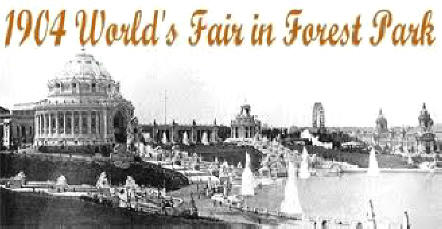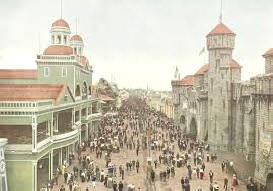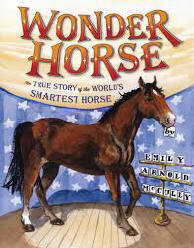

As a storyteller, I’m always on the lookout for a new, topical story. In 2003, the buzzword in the St. Louis area was the 100 “Centennial” celebration of the St. Louis World’s Fair…or more appropriately, The 1904 Louisiana Purchase Exposition (we like to call it the St. Louis World’s Fair.) I found most information at the Missouri History Museum in St. Louis, but I also used the Internet. If any pictures are shown that are copyrighted, please let me know and I will change them.
Now that the gauntlet was laid, I was on a mission to find the story.
I went to the Missouri History Museum and Archival Library to read every letter, news article, and display. Next, I went to my library and took out a boatload of books. And, yes, I did an Internet search. I did come away with some very interesting facts:
|
|
Did you know that the fair was the largest exposition of its time covering over 1200 acres in a place way, way far away from the city called “Forest Park”? It was called Forest Park because, well…it was a forest…of trees. |
|
|
I also found out that the average attendance at the fair was 86,000…and on opening day…200,000 people attended. I found it a bit disturbing, however, that our president, Teddy Roosevelt, did not come to the ribbon cutting that April…until…I found out why. It seems that 1904 was an election year and Teddy didn’t wasn’t it to seem that he was trying to take advantage of going to the fair for political reasons. So, he didn’t come to the fair until it was almost over in late November…after he won reelection. |
|
|
The price – 50 cents for adults and 25 cents for children. But, bring your wallet, because, once inside, there were plenty of ways to spend your money. |
|
|
You might be wondering, how did you
get around at the fair…it was so huge? Well, you could take the
Intramural train (that’s just a fancy name for a streetcar that ran all the
around the parameter of the fair with 17 different stations along the way.
You might ride the
gondola boats in the Grand Basin. They went from one palace to another –
The Palace of Electricity,
The Palace of Agriculture,
The Palace of Liberal Arts…the
list goes on and on with over 1500 different buildings at the fair. If you
didn’t want to boat, and you had some extra cash to throw around, you could
ride the new “roller chair” or maybe a rickshaw. There were electric cars
and even an ultra-modern autobus that held up to 40 people. If you were at
the Pike – the amusement park – you might want to ride and elephant or even
a turtle. But, I’ve got to warn you. If you go around riding a turtle, give
yourself plenty of time, because the average person spends 18 days to see
the entire fair.
|
Now, even though these facts are interesting, they simply do not tell a story. I know, to get the picture we need to take a ride on top of the world’s largest Ferris Wheel called The Observation Wheel.
The Observation Wheel was originally at the Chicago World’s Fair over a decade before. It took 175 freight cars to bring it to St. Louis. It had 36 cars and each car held between 40 and 60 people. To my way of ciphering… that’s over 1500 people on a single ride. It was so big – 250 feet that it took a whole hour to turn just 4 times!
But, as we travel to the top of the wheel we can see the whole fair.
|
|
Look, over there…that’s Festival Hall, the heart of the Fair. |
|
|
If you look just beyond it, you can see all 48 states represented in the Colonnade of States. |
|
|
And, flowing down from Festival Hall are the Cascades. |
They flow into the Grand Basin with lagoons that finger out in every direction. If you squint your eyes, you can see the gondolas that I told you about and many of the palaces, too. They are decorated to look like very ornate, white, French Renaissance palaces.
|
|
Look over there…that’s where the 1904 Olympics are being held – the very first in the United States! Athletes are running and jumping and leaping into the record books. |
Click on image for more information
|
|
And, back here, on the other side of Skinker Boulevard you can see The Pike. |

If want some fun, go to the Pike with its rides, fun houses, reenactments…and ragtime music.
|
|
If you look way, way over there…see that patch of trees (the only ones left of the forest)? That’s where the Anthropology Village is located. You can see people from the Philippines to Patagonia. Indigenous people are living there just like they do in their homeland. |
Gee, look at the people down there. They look like ants – especially the men in their dark suits and bowler hats. The women are wearing their long, summer-white muslin skirts with big hats and umbrellas to keep off the hot sun.
Even though we get the big picture of the fair from atop the Observation Wheel, I still don’t have the story. To do that we will need to go for a walk along the streets and avenues of the fair.
As we walk along we notice that there is music coming from every corner:
|
|
At the Ethnic village we hear the strange, exotic instruments of the people from Africa, Asia and even Native America. |
|
|
If we simply stand still, we are bound to hear a band come by. Listen I hear one now (play “The Liberty Bell March”). Why look…it’s none other than John Phillip Sousa playing one of his original marches. It’s called “The Liberty Bell March. Why, you ask? Well, because the Liberty Bell was on display at the 1904 World’s Fair. But, come on, time is getting away from us. Let’s get to the Pike where the real fun is. |
|
|
At the Pike and only at the Pike we can hear the ultra modern Ragtime music (play “The Entertainer”). The fathers of the fair decided that Ragtime was a bit lowbrow. That it was only a fad so it could only be played at the Pike. Ragtime is an American art form. It combined some classical, with the 2-4 time of the marching bands, with a whole lot of the African-American experience to come up these toe tapping tunes. Listen (pause). That’s none other than... |
Scott Joplin – The King of Ragtime.
Scott Joplin was born in East Texas and his mother knew right away that he had talent. So, she made sure he had classical training from a German pianist. When he grew older, he traveled around the country picking up a little bit of this and a little bit of that. When he arrived in St. Louis, he was ripe and ragged to write ragtime. You might remember this piece called “The Entertainer.” It was used in the movie “Butch Cassidy and the Sundance Kid” (pause, higher volume, and turn off)
|
|
But, come on…it’s getting late. Look, the sun is setting casting a rosy glow on the white buildings. As we pass by Festival Hall, we hear more music. When we peek inside, we see the world’s largest pipe organ being played by famous musicians from around the world. |

They play everything from Bach to Baroque – all very high-brow, don’t you know. I guess it does complement the many classical paintings and the French Renaissance architecture.
The sun has gone down. The sky is an inky black and now illumination begins. Watch as thousands upon thousands of electric lights that line the buildings, and streets, and statues slowly, slowly come to life.
Look through the new stereoscope at: Festival Hall and The Cascades at night
So bright that it blocks out the stars in the heavens! And, the Cascades are the most beautiful of all. Come on!
I just have to tell you about these Cascades. You see, if you came to St. Louis before the fair and wanted a glass of water from the tap, you had to swirl it around before you drank it, so all the silt would go to the bottom. And the fathers of the fair did not want brown water gushing out of their fountains. So, they hired the best engineers to come up a filtering system. That system not only provided clear, clean water for the fountains but good drinking water for the city of St. Louis. Now watch as the colors change from red to blue to green to purple…every color of the rainbow! Is it any wonder that Scott Joplin was so inspired that he wrote a piece of music especially for the fair called “The Cascades.”
I have to admit that the music of the fair fills my heart and gets my feet to a-tapping, but try as I might I still can’t find the story.
Ah, I know, how about pictures? You know they say that a picture holds a thousands words, and who better than show us pictures than Jesse Tarbox Beals. Jesse was born in 1870 in Ontario, Canada. When she just 12 years old and in school, they had a contest and whoever won would get a Brownie camera. Jesse set her sights on that camera and she won. Soon she was taking pictures. Then she traded that little Brownie in for a bigger then a better one, until by late 1890’s if you wanted a picture taken, you asked Jesse. As a young married woman she moved to Massachusetts and later to Buffalo, New York. It was there that Jesse was hired in 1902 as the very first woman photo-journalist by the Buffalo Herald. In 1904, they sent her on assignment to the St. Louis Fair. But the fathers of the fair were not amused. They didn’t think a woman…especially a woman of such slight stature was capable of the demanding job of taking pictures. Well, that was just the kind of thing that spurned Jesse on…she loved a good challenge. So, she heard that the village people from Patagonia did not like to have their pictures taken and they did not like to give interview, but Jesse had her winning ways. Weren’t the fathers of the fair surprised when she laid out their pictures AND their story in from of them.
So, Jesse was hired as the only official woman’s photographer at the fair, and she was fearless. She climbed to the top of the fire truck's ladder or took a hot air balloon across the grounds just to get an unusual perspective of the fair. But that's not all.
She also got pictures of the people…the visitors and the people of the ethnic village and she was always…always able to capture the humanity of the fair in her pictures.
Of course, there are some fun pictures, too:
|
|
Look at this one…it’s a picture of a statue of a life-size elephant…made completely out of almonds! And, that’s not all there are many food sculptures at the fair. |
The Corn Palace
|
|
And here’s one of a horse. Rather unremarkable in and of itself until you know the story. This horse’s name was Beautiful Jim Key http://www.beautifuljimkey.com and supposedly it could add. If you gave it an addition or subtraction problem, it was able to stamp the answer with its hoof. And that’s not all, Jim Key could spell words. If you laid lettered blocks in front of him and gave him a word, he could spell it out. Now, I think there is more to this story, and, if you click on the link above, I think you'll agree. |

“…while Seabiscuit helped reignite the American spirit, Jim Key, in his own beautiful way, whispered to Americans' hearts and awakened their soul." -- THE LOS ANGELES TIMES
· Here’s one of a giant statues made of steel called “The Vulcan.” Unlike the buildings and the other statues of the fair that were made for temporary use only, the Vulcan, the man of steel still exists. But, don’t come to St. Louis to see it. It now resides in Birmingham, Alabama.
I have to admit that these pictures do inspire me and give me a whole new perspective of the fair. But, try as I might, I still don’t have the story.
Then, one day, I was writing out some memories of what it was like. when I was a child, back in the fifties during the Fourth of July. And, suddenly, the story unfolded. It wasn’t a story of Jesse afterall, it was a story of Josie-my Great Aunt Josie. And here is the story:
In February, 2007, I presented this program for a humanities grant in Coffeyville, Kansas. Here is an article that was in the local paper....1904 World Fair Stories told at Humanities the week of February 5
REFERENCES